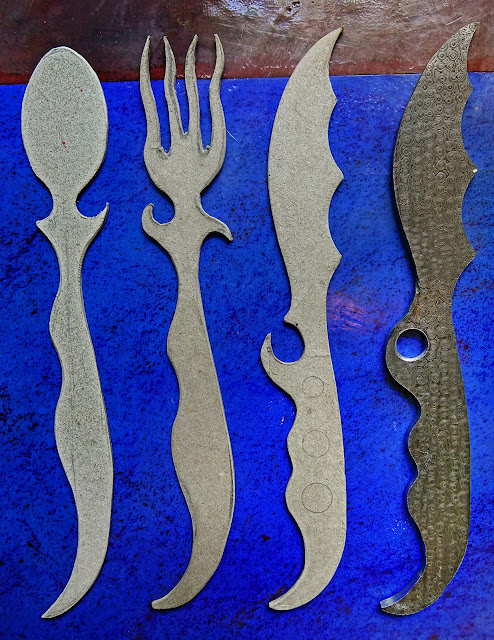The second billets I got are harder, and regular drills will not work, but I happen to have a set of "Rodman Multipurpose Carbide Tip Drill Bits" I bought years ago but never used much because most metal I needed to drill was soft enough for regular bits. Now, these Rodman bits are quite amazing, and will drill not only stone, ceramic, porcelain, but also very hard steel like a file, as shown in this video.
Sure enough, they could drill through the harder billet. I was missing some of the smaller sizes, so I ordered replacements and a couple of extras from Bad Dog Tools. The counterrotating saw did cut but seemed to dull quickly, so I am using instead a 4 1/2" grinder with thin metal cutting disks. I went ahead and made the blank for the Soup Spoon. The challenge was going to be with the forks, so I planned my straight grinder cut carefully, and drew them on the billet. I sprayed the Sharpie lines lightly with fixative:
I drilled 1/8" holes between the teeth of the forks. It ended up easy enough to shape the blanks for two forks. The billet gets hot and needs to be cooled periodically in a bucket of water. I started grinding the blade of the knife:
I believe it will probably be best to refine the shapes of the blanks as much as possible before bending the forks and spoons to shape, which will require heating with a torch. I am debating how to do the spoon, and think I will start shaping it by grinding the center on one side and the edges on the other. Then, I can heat it red with a torch and deepen the cup hitting the center with a ball pen hammer. I will test it with a regular piece of steel.
Sure enough, they could drill through the harder billet. I was missing some of the smaller sizes, so I ordered replacements and a couple of extras from Bad Dog Tools. The counterrotating saw did cut but seemed to dull quickly, so I am using instead a 4 1/2" grinder with thin metal cutting disks. I went ahead and made the blank for the Soup Spoon. The challenge was going to be with the forks, so I planned my straight grinder cut carefully, and drew them on the billet. I sprayed the Sharpie lines lightly with fixative:
I drilled 1/8" holes between the teeth of the forks. It ended up easy enough to shape the blanks for two forks. The billet gets hot and needs to be cooled periodically in a bucket of water. I started grinding the blade of the knife:
I believe it will probably be best to refine the shapes of the blanks as much as possible before bending the forks and spoons to shape, which will require heating with a torch. I am debating how to do the spoon, and think I will start shaping it by grinding the center on one side and the edges on the other. Then, I can heat it red with a torch and deepen the cup hitting the center with a ball pen hammer. I will test it with a regular piece of steel.











